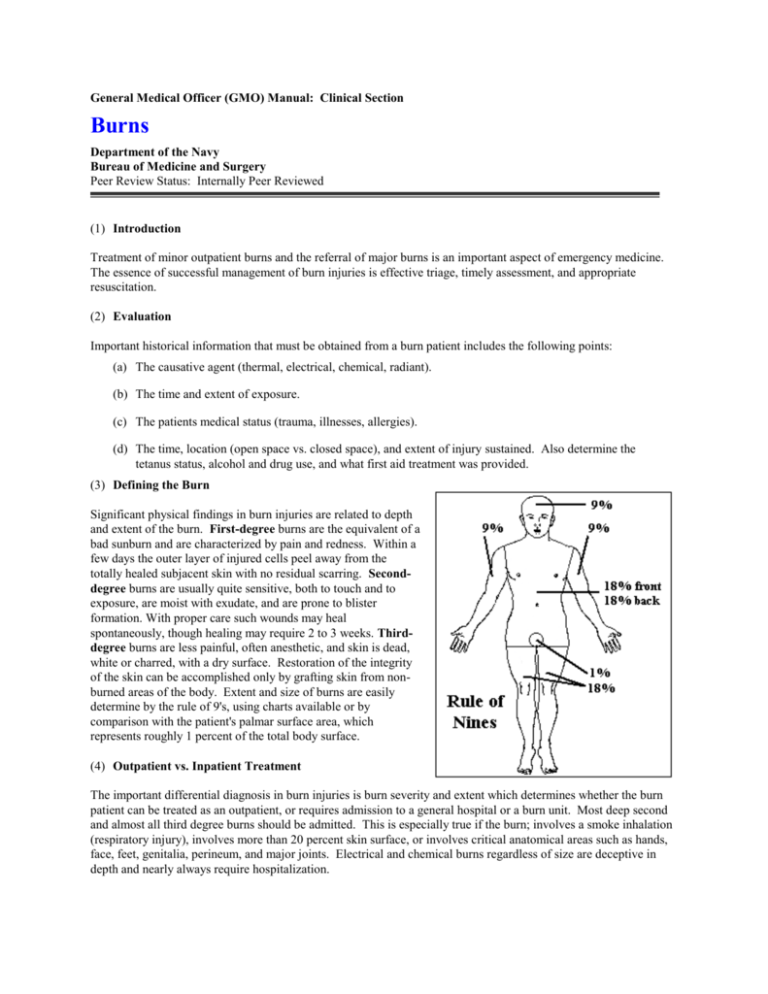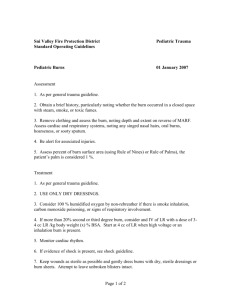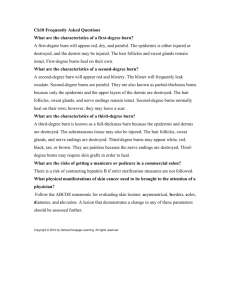burns - The Brookside Associates
advertisement

General Medical Officer (GMO) Manual: Clinical Section Burns Department of the Navy Bureau of Medicine and Surgery Peer Review Status: Internally Peer Reviewed (1) Introduction Treatment of minor outpatient burns and the referral of major burns is an important aspect of emergency medicine. The essence of successful management of burn injuries is effective triage, timely assessment, and appropriate resuscitation. (2) Evaluation Important historical information that must be obtained from a burn patient includes the following points: (a) The causative agent (thermal, electrical, chemical, radiant). (b) The time and extent of exposure. (c) The patients medical status (trauma, illnesses, allergies). (d) The time, location (open space vs. closed space), and extent of injury sustained. Also determine the tetanus status, alcohol and drug use, and what first aid treatment was provided. (3) Defining the Burn Significant physical findings in burn injuries are related to depth and extent of the burn. First-degree burns are the equivalent of a bad sunburn and are characterized by pain and redness. Within a few days the outer layer of injured cells peel away from the totally healed subjacent skin with no residual scarring. Seconddegree burns are usually quite sensitive, both to touch and to exposure, are moist with exudate, and are prone to blister formation. With proper care such wounds may heal spontaneously, though healing may require 2 to 3 weeks. Thirddegree burns are less painful, often anesthetic, and skin is dead, white or charred, with a dry surface. Restoration of the integrity of the skin can be accomplished only by grafting skin from nonburned areas of the body. Extent and size of burns are easily determine by the rule of 9's, using charts available or by comparison with the patient's palmar surface area, which represents roughly 1 percent of the total body surface. (4) Outpatient vs. Inpatient Treatment The important differential diagnosis in burn injuries is burn severity and extent which determines whether the burn patient can be treated as an outpatient, or requires admission to a general hospital or a burn unit. Most deep second and almost all third degree burns should be admitted. This is especially true if the burn; involves a smoke inhalation (respiratory injury), involves more than 20 percent skin surface, or involves critical anatomical areas such as hands, face, feet, genitalia, perineum, and major joints. Electrical and chemical burns regardless of size are deceptive in depth and nearly always require hospitalization. Smaller burns which appear to be partial thickness in depth may be treated as an outpatient provided the patient can obtain frequent follow-up examination, his or her dressing changes and medications are appropriately monitored, and the symptoms and findings are not deteriorating under treatment. (5) Management All major burns (greater then 20 percent full or partial thickness) require appropriate advanced trauma life support (ATLS) protocol with emphasis on airway and fluid resuscitation and transfer to a burn center. The more common smaller partial thickness burns may be treated as outpatient after thorough washing with surgical soap (Hibiclens or Phisohex) and application of a sterile non-adherent dressing such as Xeroform or Adaptic gauze covered by a sterile bandage. Further management requires protection from the environment with application clean dressing and bandages, daily, or twice daily along with cleaning with a mild soap until the burn has healed. Topical antimicrobials (i.e., Silvadene) systemic antibiotics should not be applied to these burns unless there are specific indication for these drugs (i.e., signs of infection). Blisters or bullae that are small and intact need not be opened or removed unless they impede pint motion or show signs of infection. Superficial small size burns about the face can be treated open (without dressing) by daily cleaning and application of Bacitracin ointment. Tetanus prophylaxis and analgesics should be used as indicated. (6) When to refer Should during the outpatient treatment of smaller burns, the wounds show signs of infection or the burn fails to heal within 2 weeks, the patient should be referred for hospitalization and more extensive treatment. Patients with major burns that meet the American Burn Association (ABA) criteria for burn center referral should be assessed, stabilized, and immediately transferred to a burn center. This requires physician-to-physician contact to assure the patient's needs are met throughout every aspect of the transfer. In the military system, burn center referral can be obtained through the Army Institute of Surgical Research (Brook Army Medical Center Burn Unit); by telephone request 24 hours per day to the duty physician (512)-221-2943, DSN: 471-2943, or (512) 222-2876. References (a) Advances in Burn Care, Clinic in Plastic Surgery, 1986,13:1, W. B. Saunders (b) Am. Burn Life Support Provider's Manual, 1990, Nebraska Burn Institute, Artz, Moncrief and Pruit, 1979. (c) Burn, A Team Approach, W. B. Saunders, William F. McManus, M.D., Colonel, MC, USA, Personal Communication Wiener and Barrett, 1986, Trauma Management, chapter 5, W. B. Saunders Originally written by CAPT Robert F. Brewer, MC, USN, Department of Plastic Surgery, Naval Medical Center Portsmouth. Reviewed by CAPT Patrick W. Lappert, MC, USN, Head, Department of Plastic Surgery, Naval Medical Center Portsmouth, VA (1999).







